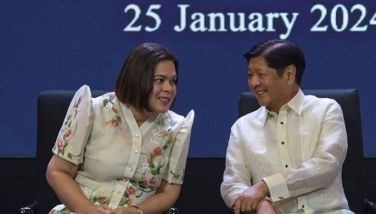Resilient supply chains, beyond potatoes and cheese

In our pre-pandemic world, nobody – at least none of us ordinary consumers – cared about how the things we needed or even those we didn’t need but simply wanted, reached us, whether it’s melt-in-your mouth cheese on our favorite ensaymada, potatoes for french fries, a spare part for our camera, an upgraded laptop or the latest version of our favorite mobile phone.
We would simply run to the mall or drive through our favorite fast-food chain and we’d be back home satisfied.
But when the pandemic struck, the harsh reality reared its ugly head. Access to even just the most basic necessities, at least at the time – from face masks to face shields – became difficult. You had to make calls to people in places who might have what you needed or resort to the black market and settle for the exorbitant prices.
There was a crunch in supply and we all knew it. China, known as the world’s factory, was the first country to enforce the quarantine and lockdown of cities and later, whole provinces in late January 2020.
The result was that whether we liked it or not, whether other countries admit it or not, the world’s biggest factory was closed until further notice and it hit us hard.
All of us, one way or another, were surely affected.
Challenges of the 21st century
This problem has become one of the biggest challenges of the 21st century, said visiting US Trade Representative Katherine Tai.
I had the chance to sit down with Ambassador Tai in a roundtable discussion with my fellow journalists on Tuesday at the US Ambassador’s residence in Makati. It was an extensive and very interesting discussion on a wide range of trade issues.
I had the chance to ask her about the challenges of our time in the area of trade and she said that one such challenge is how to have a more resilient supply chain.
“There are a lot of challenges....With respect to the pandemic, one of the things we really saw all at once very thoroughly was the vulnerability of our supply chains, especially in the early pandemic. We had a kind of demand shock. We were all needing the same things at the same time – masks, gloves, ventilators. We were also trying to struggle to understand the nature of these particular buyers and so demand exceeded supply. There’s just not enough for all of us,” Ambassador Tai said.
One of the solutions, she said, is to create an environment where production of goods and services isn’t concentrated in just one or a few countries.
“We started to realize that these products are actually only produced in a couple of places and one of those places was the first country to fully lock down, so nothing was coming in and going out,” she noted.
Indo-Pacific Economic Framework
How best to move forward and create incentives in trade and economics for companies to make decisions that aren’t just based on maximum efficiency is a major element of the so-called Indo-Pacific Economic Framework (IPEF), launched in May last year.
The US government is thus pushing this key trade program with the hope of creating a trading environment that is more resilient, sustainable and with sources of goods not just coming from a few places such as China.
Ambassador Tai said the key is to provide incentives to companies so they don’t just look for cheap cost but efficient operations.
She also touched on the climate crisis and how the US government wants to see a global trading environment that provides incentives to economic behaviors that make our respective economies more sustainable, not just for the planet but for the workers.
Traditional free trade agreements
Against this backdrop, the US is not prioritizing the traditional free trade agreements (FTAs) for now but rather prioritizing the IPEF.
Perhaps, the US has realized that simply liberalizing trade made the environment vulnerable, even though it made trade easier.
Ambassador Tai said compared to the traditional FTAs, the IPEF is seen as “being appropriate for the types of challenges and opportunities that we’re facing right now.”
The program has four pillars including trade, supply chain resilience, infrastructure and clean energy, and tax and anti-corruption.
“We’re not just trying to liberalize because that’s led to very fragile supply chains. We’re trying to figure out what are the trade tools that we can use to serve the larger purpose of promoting resilience, sustainability and inclusiveness,” she said.
It is unlike traditional more structured FTAs, where the backbone are market access commitments and tariff cuts.
Renewed energy
There are many things to watch out for and one is how the private sector will respond to it.
It’s also interesting to see how this will affect our geopolitical reality today in the context of the broader superpower competition between the US and China – or the eagle and the dragon – and how the Philippines will respond to it.
We would have to watch how the negotiations play out between the US and its trading partners, Philippines included.
What’s clear for now is that there is renewed energy surrounding US-Philippines relations. The US embassy in the Philippines led by Ambassador to the Philippines MaryKay Carlson is as busy as ever. We now have to wait and see how the benefits would actually trickle down to us as a people.
* * *
Email: [email protected]. Follow her on Twitter @eyesgonzales. Column archives at EyesWideOpen on FB.
- Latest
- Trending


























